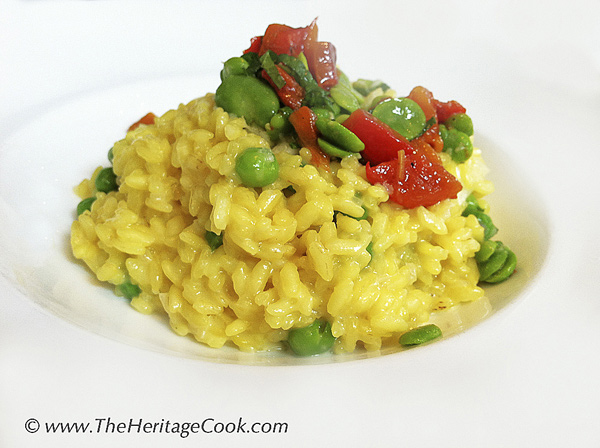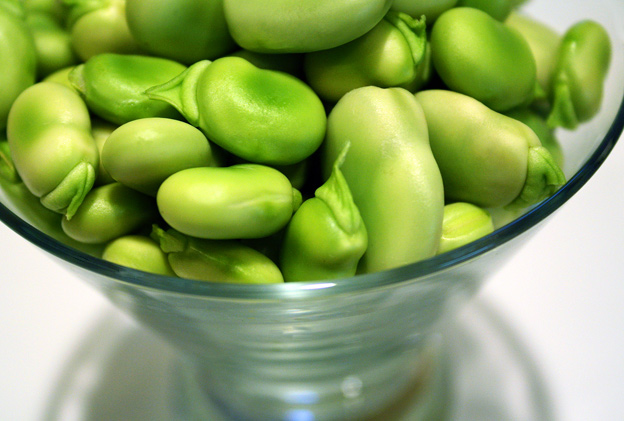Happy Festive and Good Friday everyone! If you are hosting Easter dinner this year and have someone joining you who is gluten-intolerant, dairy-intolerant or a vegetarian, adding this dish to your menu will allow all of your guests to enjoy themselves. It also makes the perfect side dish to most traditional Easter entrees. I make this often in the spring with fava beans are at their peak and I wait all year to feature them!
Ahhhh risotto. My dream dish and the bane of my existence and I know I am not alone. Yep, you heard it here on The Heritage Cook folks … I have struggled for years to make decent risotto. For a long time I thought I was not stirring it enough or wasn’t using the right amount of liquid, keeping my homemade risotto from being something that people begged for. But it was much simpler than that.
Now I know it was the rice I was using! For many years Arborio rice was what all the cookbooks and TV shows told me I should be using. While it is still a great option, a far easier rice to use and have great success with is Carnaroli.

Carnaroli Rice
Carnaroli is a high-starch rice similar to Arborio but larger in size. The starch is what creates the creamy texture of risotto. It holds liquid and its shape better resulting in a risotto that is fluffy without becoming sticky and clumpy. Carnaroli is grown in the Northern Italian town of Vercelli, near Milan and Turin close to the borders of France and Switzerland. When you use carnaroli you will wind up with a dish of grains that are firmer and an all around more pleasing texture.
Last week The Artist and I had dinner at our favorite neighborhood restaurant. I chose the saffron and pea risotto. As usual, our meals were outstanding, but the risotto was especially good. The rice itself was perfectly cooked and seasoned and the chef had topped it with a combination of fresh fava beans and tomatoes in a light vinaigrette. The bright spark of flavor from the lightly acidic concasse made the dish much more memorable.
A vinaigrette is very simple to make and much more flavorful than anything store bought. It stores well in the refrigerator and can be supplemented when it gets low. I keep a small jar of it ready for dishes like this and to toss with our salads.
Because English peas and favas are in season now, I encourage you to buy them at the market and discover their delightful flavors. But if you can’t find them or they are out of season, you can easily substitute frozen. Remember that frozen vegetables have been par-boiled before processing which is why they don’t take as long to cook. Follow the directions under “Tips and Hints” below if using them.
To make sure I was on the right track, I went looking for a similar risotto recipe and found a fantastic one from Chef Jonathan Waxman, the chef-owner of New York City’s Barbuto. I did take some liberties, to replicate the meal from the restaurant, but a great basic recipe is true treasure.
Having a binder of basic or “master” recipes is a great way to become a better cook. Start with something basic and then add ingredients and seasonings to change them. See how many variations you can come up with. Your family and friends will have fun being judges of your creations!
Happy Festive Good Friday – have a fabulous holiday weekend!!

Saffron Threads
Jane’s Tips and Hints:
If using frozen peas or fava beans, place them in a small saucepan, add about 1 inch of water, cover and bring to a boil over medium-high heat. As soon as the water comes to a boil, remove from the heat and set aside for 2 minutes. Drain and add to risotto or tomato concasse.
Gluten-Free Tips:
If you are not using homemade stock, make sure the brand you use is gluten-free. If you need to avoid dairy, leave out the Parmesan cheese. To make this vegan, use olive oil instead of butter, increase the salt slightly, leave out the cheese, and use vegetable stock.
Kitchen Skill: Preparing Tomato Concasse
Core and peel tomatoes. Cut in half horizontally (along the “equator”) and squeeze out the seeds and membranes. Cut the tomatoes into a small dice, 1/4- to 1/2-inch pieces.


- Vinaigrette
- 1/4 cup red wine vinegar
- 1 tsp Dijon mustard
- 3/4 cup extra virgin olive oil
- Kosher salt and freshly ground black pepper, to taste
- 1 tsp fresh thyme leaves, optional
- Garnish
- 3 medium-sized ripe tomatoes
- 1 cup shelled fava beans
- 1 tsp finely minced shallot
- 2 tbsp basil chiffonade
- Risotto
- 2 cups shelled fresh English peas (or frozen, see note above)
- 1 stick (4 oz) butter
- 1 onion, peeled and finely minced
- Sea salt to taste
- 2 cups Carnaroli rice
- 2 cloves garlic, peeled and sliced lengthwise
- 2 cups good white wine, preferably Sauvignon Blanc
- 4 cups light chicken stock, vegetable stock, or water
- 1 tsp loosely packed saffron threads
- 1/4 cup grated Parmesan, optional
- 1/4 tsp coarsely ground black pepper
- Make Vinaigrette: Combine all the vinaigrette ingredients, whisking to combine thoroughly. Alternately, you can place them in a jar with a tight lid and shake to emulsify.
- Prepare Garnish: Bring a large pot of water to a boil. Fill a large bowl with water and add 12 to 24 ice cubes.
- Cut out the core of the tomatoes and dip them into the boiling water for about 30 seconds. Immediately transfer them, using a slotted spoon or spider, to ice water to shock them. Remove from the water and the skins will easily peel off.
- Using the same pot of hot water, repeat the process to blanch the fava beans, cooking them for about 2 minutes or until bright green and tender. (Can be prepared up to four hours ahead; cover and refrigerate.)
- Cut tomatoes in half horizontally (along the “equator”) and squeeze out the seeds and membranes. Cut the tomatoes into a small dice, 1/4 to 1/2-inch pieces. (Can be prepared up to two hours ahead; cover and refrigerate.)
- In a small bowl, combine the tomatoes, favas and shallots. Sprinkle with a pinch of kosher salt and a little freshly ground black pepper. Toss with 2 tbsp of the vinaigrette, taste, and adjust seasonings to taste. Stir in the basil chiffonade just before serving.
- Prepare Risotto: Bring a pot of salted water to a boil. Blanch the peas for 2 minutes. Drain, immerse in ice water to halt the cooking, and drain again. Set aside.
- Bring the stock to a simmer. Reduce heat to hold the stock at just below a simmer.
- In a heavy casserole or Dutch oven, melt the butter over medium heat. Add the onion and sweat for 5 to 8 minutes, stirring regularly, until translucent. Season to taste with sea salt. Add the rice and continue to cook, stirring, for 4 minutes. Add the garlic and cook 1 minute longer, and then add the wine.
- Cook until the wine has reduced to 1/2 cup, and then slowly add the hot stock, 1/2 cup at a time, each time allowing the rice to absorb the liquid before adding more. You want the risotto to remain loose, but not too soupy. When you have added about half the liquid, stir in the saffron threads.
- Continue to add more stock until the rice is tender but still firm when you bite it (al dente). Add the peas, Parmesan (if using), and black pepper. Taste for seasoning and add more salt if needed. Note: the cheese is quite salty. If you do not include it, you will likely need additional salt to compensate and balance the flavors.
- To Serve: Just before serving, add a little more hot stock, if needed, to keep the rice loose. Scoop the risotto into warmed serving bowls. Top each with about 2 tbsp of the garnish and serve immediately.
- Yield: 6 to 8 servings
Create a New Tradition Today!
Unauthorized use, distribution, and/or duplication of proprietary material on The Heritage Cook without prior approval is prohibited. This includes copying and reprinting content and photographs. If you have any questions or would like permission, I can be contacted via email: theheritagecook (at) comcast (dot) net. Feel free to quote me, just give credit where credit is due, link to the recipe, and please send people to my website, www.theheritagecook.com. Please see the Disclaimers page (under the “About” tab above) for additional details.
Thank You!










sippitysup
OMG! XOGREG
Jane Bonacci, The Heritage Cook
Thanks Greg! Hugs to you both and Happy Easter!!